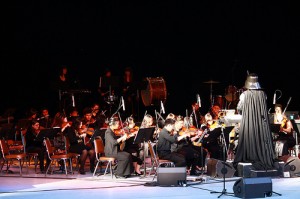Songs of Myself (Part 7)
By Asher Crispe: September 2, 2014: Category Inspirations, Simple Rhythms
 Ever watch a horror movie with the sound off? Not so scary as one might think. Sometimes the effect of muting or even dropping the volume to a whisper steals the thrill right out from under our eyes. As much as we might be attracted to love songs and all of their feel-good energy, we also seek the screaming intensity of music which overpowers us, that knocks us down or holds us at the edge of our seats. It adds so much to our other senses. In its raw power, with beating drums and crashing cymbals along with all manner of other big noises and colossal sounds, we get pumped, amped, electrified.
Ever watch a horror movie with the sound off? Not so scary as one might think. Sometimes the effect of muting or even dropping the volume to a whisper steals the thrill right out from under our eyes. As much as we might be attracted to love songs and all of their feel-good energy, we also seek the screaming intensity of music which overpowers us, that knocks us down or holds us at the edge of our seats. It adds so much to our other senses. In its raw power, with beating drums and crashing cymbals along with all manner of other big noises and colossal sounds, we get pumped, amped, electrified.
Progressing through the array of musical synonyms as they are wed to aspects of the self and powers of the soul, our next mark is gevurah which might be floated in translation as severity, restraint, or might. Popping the hood on this reactive term, we see that its running on high octane fear underneath. Causing our hair to stand on end and cutting deep into our fleshy heart, this musical form makes quite an impression. We clench our stomach muscles. We contract. We hold our breath. Our unique musical word for this is zemir. The connection becomes clear in passages that speak of the “song of tyrants” [zemir aritzim] (Yeshiyahu / Isaiah 25:5). ‘Aritzim’ refers to those mighty ones who evoke fear and dread–thus forging the connection between this kind of music and imposing figures of power with all of their ferociousness.
Not long ago, I watched a You Tube performance of a symphony orchestra–the sort that reaches down into their bag of light, entertaining tricks to amuse an audience no longer patient and primed for the long strokes and complex movements of classical music in the absence of some attending visual stimuli–as they leapt into a rendition of John William’s famed Imperial March from the soundtrack to the original Star Wars movie. To take it completely over the top, they positioned an actor backstage clade in a convincingly realistic Dark Vader costume. Then, on queue, much like how the fictional character would in the film, he makes his grand entrance, slowly marching though the rows of the performing orchestra till he brushes aside the conductor and mounts the platform and fascistically leads the frenzied musicians through the remainder of the piece to the audible cheers and laughter of the audience. If it weren’t a total charade, we would have undoubtably ducked under our seats or run for our lives in face of this iconic super villain. He has a theme all his own.
From the first few bars (unless you’re really good and then a few notes will suffice) we recognize exactly who is associated with this music. The notion of linking characters with musical themes (or more technically leitmotif) is nothing new. Though many living in the post Star Wars era might erroneously attribute this as a John Williams innovation, the practice was made particularly famous in the meta-dramas of Wagnerian opera in the 19th century (most notably in his Der Ring des Nibelungen). In either case, we record in our memory the mood evoked by each leitmotif and tie it to a character so that, every time it is revisited, we are already planted back where we were throughout the history of getting to know this personage. The music alone proves sufficient to allow us to retrieve the profile on this imaginary individual. They cease being a person and instead emerge from the cocoon of their personhood and take off with the butterfly wings of universal ideas and abstract notions. Likewise, certain musical gestures immediately signal to us that we are about to be inundated with a particular experience. We hear the dark. A storm is approaching.
Who composes music of this sort? While they don’t have a monopoly on it, the sons of Korach produced some fervent melodies that became canonized in the book of Psalms. Take for example the recurrent phrase “from the sons of Korach a song (mizmor)” (Psalms 84:1) which stems from our above mentioned term zemir. Recounting their background in brief: the sons of Korach initially followed their father in his rebellion against the leadership of Moshe / Moses. Yet, while Korach and his followers were recorded in the Torah as being punished by the earth opening up and swallowing them into the mouth of hell (gehinom), a point is made in the text (Numbers 26:11) to single the sons out as having repented their actions in the last moment, which consequently saved them as they fell. They did not die but rather were maintained alive within an elevated spot in the opening to hell. According to the Talmud (Sanhedrin 110a), they eventually escaped and relocated to the land of Israel where they attained the status of prophets.
What does this mean for the budding musicologist? It suggests that there is a special inspiration that gets channelled into music when a person feels that he or she has just been to hell and back. To exist in a living hell—in the pit of despair—amidst the fires of anguish—to lose one’s grounding and collapse inwardly as though consumed by one’s environment—to be buried alive or by life—is the context out of which their music emerged.
Being swallowed up by the earth symbolizes the fallacy of old-fashioned materialist reductionism that renders the foreground of everything alive as an illusion masking a cold, dark, dead and inert background set of building blocks that are the only things that persist. We must designate it as ‘old-fashioned’ to the degree that this view has now been outstripped by the success of quantum physics and the science of information. Tunneling into the coarse and seemingly closed material substrate of our world, we expect to find nothing other than its unqualified self-consistent density, but we instead are astonished to encounter that the material itself evidences its own dematerialization–that it all dissolves into something akin to a thought. Information, immaterial as it may be, ultimately constitutes the basis for the material.
From this long digression, we may glean another insight into the nature of gevurah or severity. Often in Kabbalah, gevurah is identified with the power of contraction or self-limitation known as tzimtzum. At its root, it proves to be the origin of finitude. Thus, to be taken in by the ‘nothing-but-ness’ of arresting materiality is tantamount to being punished by the very harshness of this view of existence. Yet, at the same time holding oneself a bit aloof from it, keeping a skeptical reserve, results in the sons of Korach being granted a modicum of transcendence even within the hellishness of their hole. Staying above even while having fallen down and living inside this existential purgatory, yields the tension and dissonance for the music of sadness and of loss.
 How to extract oneself from such circumstances? For anyone who has been to hell and back and turned that world of hurt into a song, we find consolation in listening to those melodies and recalling our own challenges. On some level this music may prove insightfully, even prophetic. It might help us find our way out and up and carry us home. We can sing from afar. We can sing from down low. The distance moves us. We shudder and look for our place.
How to extract oneself from such circumstances? For anyone who has been to hell and back and turned that world of hurt into a song, we find consolation in listening to those melodies and recalling our own challenges. On some level this music may prove insightfully, even prophetic. It might help us find our way out and up and carry us home. We can sing from afar. We can sing from down low. The distance moves us. We shudder and look for our place.
When we take all of our suffering and spin it into a song–a cry of heartache, the pain of breaking up, depression poetry–we are using our feeling of being crushed to transform our psychological lump of coal into a diamond. Some may remember the raw emotional intensity of Glen Hansard’s bleating voice singing “Leave” in the 2007 indie hit film Once. Regardless of your musical reference, the spirit of zemir captures this overpowering feeling. Is it also heavy metal and pyrotechnics? Throbbing speakers? Deafening sound? Nail biting and scratching? Armed forces? Industrial equipment? A thunder dome? Backlit Film Noir scenes? Weeping and melancholy? A zemir melody relates to all of the above.
In Part 8 we will explore an additional function of the term zemir which pertains to memory.
http://www.interinclusion.org/inspirations/songs-of-myself-part-8/
http://www.interinclusion.org/inspirations/songs-of-myself-part-6/













;)
;)
;)
;)
;)
;)
;)
;)
;)
;)
